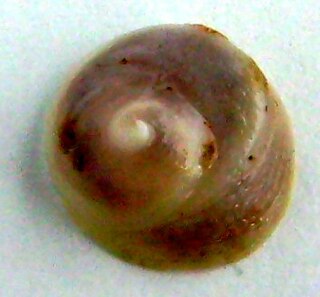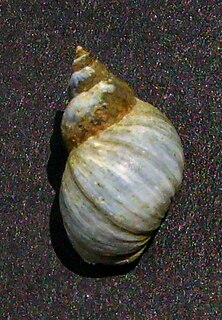
Powelliphanta is a genus of large, air-breathing land snails, pulmonate gastropods in the family Rhytididae, found only in New Zealand. They are carnivorous, eating invertebrates, mostly native earthworms. Often restricted to very small areas of moist forest, they are prey to introduced mammalian predators, and many species are threatened or endangered.

The family Sciomyzidae belongs to the typical flies (Brachycera) of the order Diptera. They are commonly called marsh flies, and in some cases snail-killing flies due to the food of their larvae.
Molluscicides, also known as snail baits and snail pellets, are pesticides against molluscs, which are usually used in agriculture or gardening, in order to control gastropod pests specifically slugs and snails which damage crops or other valued plants by feeding on them.

Whelk is a common name that is applied to various kinds of sea snail. Although a number of whelks are relatively large and are in the family Buccinidae, the word whelk is also applied to some other marine gastropod species within several families of sea snails that are not very closely related.

The New Zealand mud snail is a species of very small freshwater snail with a gill and an operculum. This aquatic gastropod mollusk is in the family Tateidae. It is an invasive species in many countries, where populations of the snail can reach phenomenal densities.

Captain Frederick Wollaston Hutton, FRS, was an English-New Zealand scientist who applied the theory of natural selection to explain the origins and nature of the natural history of New Zealand. An army officer in early life, he then had an academic career in geology and biology. He became one of the most able and prolific nineteenth century naturalists of New Zealand.

New Zealand is a sovereign island country in the southwestern Pacific Ocean. The country geographically comprises two main landmasses—the North Island, and the South Island —and around 600 smaller islands. New Zealand is situated some 2,000 kilometres (1,200 mi) east of Australia across the Tasman Sea and roughly 1,000 kilometres (600 mi) south of the Pacific island areas of New Caledonia, Fiji, and Tonga. Because of its remoteness, it was one of the last lands to be settled by humans. During its long period of isolation, New Zealand developed a distinct biodiversity of animal, fungal, and plant life. The country's varied topography and its sharp mountain peaks, such as the Southern Alps, owe much to the tectonic uplift of land and volcanic eruptions. New Zealand's capital city is Wellington, while its most populous city is Auckland.

Paryphanta is a genus of land snails in the family Rhytididae. Species from New Zealand are known commonly as kauri snails. They are closely related and similar to snails in the genus Powelliphanta, which was formerly included within Paryphanta.

Rhytididae is a taxonomic family of medium-sized predatory air-breathing land snails, carnivorous terrestrial pulmonate gastropod molluscs in the superfamily Rhytidoidea.

Powelliphanta augusta or the Mount Augustus snail, previously provisionally known as Powelliphanta "Augustus", is a species of large, carnivorous land snail, a terrestrial pulmonate gastropod mollusc in the family Rhytididae. Naturally occurring only on Mount Augustus near Westport on New Zealand's South Island, their entire habitat was destroyed by coal mining. The world population was taken into captivity, in theory until their habitat was restored and they could be released. The mining company concerned went bankrupt and habitat restoration has been unsuccessful, so the species' future is uncertain.

A plait is an anatomical feature which is present the shells of some snails, or gastropods. This sculpture occurs often in the shells of marine gastropod mollusks in the clade Neogastropoda, but it is also found in some pulmonate land snails.

The Calyptraeidae are a family of small to medium-sized marine prosobranch gastropods. This family includes the slipper snails, the Chinese hat snails,, and the cup-and-saucer snails among others.

A land snail is any of the numerous species of snail that live on land, as opposed to the sea snails and freshwater snails. Land snail is the common name for terrestrial gastropod mollusks that have shells. However, it is not always easy to say which species are terrestrial, because some are more or less amphibious between land and fresh water, and others are relatively amphibious between land and salt water.

Austrolittorina antipodum, known as the banded periwinkle, is a species of small sea snail, a marine gastropod in the winkles and periwinkles family, Littorinidae. It is found in New Zealand. It occurs in New Zealand.

Cancellariidae, common name the nutmeg snails or nutmeg shells, are a family of small to medium-large sea snails, marine gastropod mollusks in the clade Neogastropoda. Some of the shells of the species in this family resemble a nutmeg seed.

Janthina janthina, common name the violet sea-snail or common violet snail, is a species of holoplanktonic sea snail, a marine gastropod mollusk in the family Janthinidae, the violet snails or purple storm snails.

Placostylus ambagiosus is a species of flax snail, a large air-breathing land snail, a terrestrial pulmonate gastropod mollusc in the family Bothriembryontidae.
Arthur William Baden Powell was a New Zealand malacologist, naturalist and palaeontologist, a major influence in the study and classification of New Zealand molluscs through much of the 20th century. He was known to his friends and family by his third name, "Baden".
HarperCollins Publishers L.L.C. is one of the world's largest publishing companies and is one of the Big Five English-language publishing companies, alongside Penguin Random House, Simon & Schuster, Hachette and Macmillan. The company is headquartered in New York City and is a subsidiary of News Corp. The name is a combination of several publishing firm names: Harper & Row, an American publishing company acquired in 1987, together with UK publishing company William Collins, Sons, acquired in 1990.

The International Standard Book Number (ISBN) is a numeric commercial book identifier which is intended to be unique. Publishers purchase ISBNs from an affiliate of the International ISBN Agency.
















